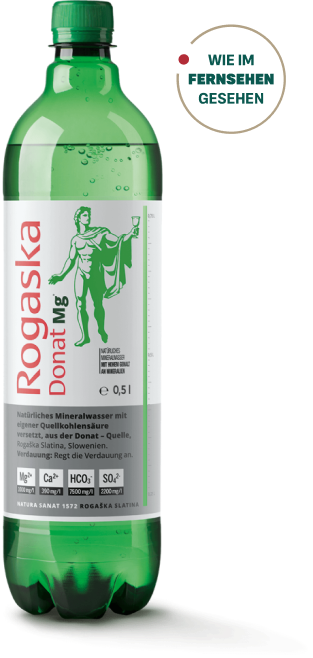Natura Sanat 1572 Rogaska Slatina mineral healing water
Celtic finds and coins from Roman times show that people knew about and benefited from the health-promoting effects of natural mineral water even in prehistoric times. Nevertheless, it was not until 1572 that the Swiss alchemist Leonhard Thurneysser scientifically analyzed the miraculous water for the first time, thus paving the way for a precise description of its properties. It was not until a century later that Dr. Paul Sorbait, court physician and professor at the Medical Faculty in Vienna, described the water in his work Praxis Medicae, which made the mineral water from Rogaška Slatina famous beyond the borders of the Habsburg monarchy.
The history:
Donat Mg was bottled in Rogaška Slatina from 1904 onwards, using ladles to fill the bottles directly from the rebuilt and covered spring. Until the First World War, 3 million bottles were bottled annually. In 1972, a new bottling plant was opened, which is Still in operation today.
In 1907, during further drilling, the astonishing discovery was made that the water had a very high magnesium content. For this reason and because of its proximity to the Donačka Gora mountain, it was named Rogaska Donat Mg.
After the Second World War, water is now extracted from expanded boreholes at depths of between 280 and 606 metres.
Healing water could not wish for a better advocate than the god of beauty and health. Even though Pegasus actually discovered the Rogaška spring, it was Apollo who was so taken by the invigorating water that he even gave up the water from the spring on the holy Mount Helikon for it. For this reason, Apollo Still adorns every bottle of the unique natural mineral water Rogaska Donat Mg.
The source:
Around the original springs in Rogaska Slatina – north-west of the Donačka quarry – there are very old limestones, probably Lower Permian (285 million years old), with a small proportion of quartz sandstone and clay slate. These are separated from the otherwise predominant Tertiary rocks. These ancient fissure aquifers store highly mineralized carbonic acid water, which is separated from shallower water-bearing layers by thick marl layers. Donat Mg therefore rises with natural gas pressure and is piped (separate from the natural carbonic acid) to the bottling plant. The first shallow spring catchments were built in 1730. It was only the later spring catchments from 1907 onwards that led to the development of another type of mineral water, namely Donat Mg.
Health:
The most important element of the mineral healing water is magnesium, which is contained in the water in its original form. One liter contains 13g of dry matter, of which more than 1,000 mg is magnesium. Due to its richness in magnesium and other minerals, it has become a symbol of the renewal of the body and is therefore indispensable for complaints such as constipation, heartburn, diabetes, high blood pressure, stress and during pregnancy.
Thanks to its content of minerals necessary for a healthy life, the mineral healing water of Rogaška Slatina is one of the richest magnesium mineral waters in the world (right after ROI and other waters in the region).
A unique, natural combination of five minerals is the hidden recipe for Donat's positive effect on the proper functioning of the organism and overall well-being.
Donat works according to the principle of osmosis - first, the sulfates absorb the water from the intestinal wall cells, which increases the volume of the intestinal contents. Magnesium also relaxes the digestive tract muscles, thereby helping the sulfates to stimulate and accelerate peristalsis.
For further information and important drinking instructions please read here or download the attached files.
Don't drink too much of it.
https://www.rogaska-medical.com/de/donat-mg/effects
donat.com
1000ml 1 PET bottle Donat Mg
Text Patrick Eckert, FINE LIQUIDS | Sources: Wikipedia, manufacturer website & ANNA-KATHARINA BRÜSTLE & NINA RMAN




















